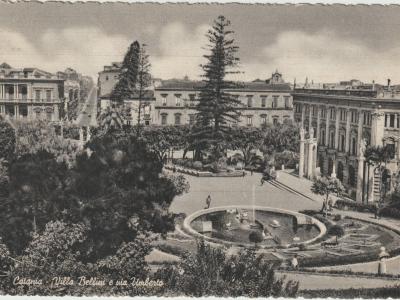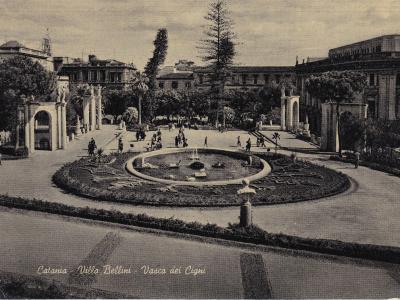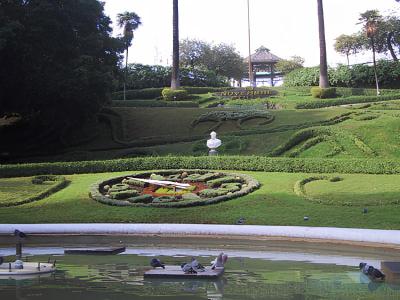It occupies, as a whole, an area of 70,942 square meters within which are arranged, flower beds, squares for sports and musical events, benches for resting and reading, shaded avenues and fountains. Part of the space, now occupied by the villa, constituted the ancient "Labyrinth," a picturesque garden that surrounded a building constructed in the 1700s by Ignazio Paternò Castello prince of Biscari. The habit of building gardens with intricate paths in which guests could easily get lost was one of the many fashions prevalent in eighteenth-century Europe when rationality and fantasy, a taste for ?wonders' and scientific rigor, merged and coexisted. Around the middle of the nineteenth century the City of Catania acquired the villa of the Paternò Castello family to build a public park. In the following years, new land was acquired to give even more space to the garden and allow the people of Catania to go to a large green place, rich in floral decorations, palm trees, hundred-year-old trees and fountains. Among the pages of a brief but essential guidebook to Catania, published in 1899, we find a tasty description of the garden, which, since its opening, was considered one of the most beautiful in Europe. "The Bellini Garden is the most sympathetic and pleasant haunt of the city. Its location is enchanting.
Villa Bellini consists of two hills: the one to the north, known as the Hill of the Savior and surrounded by an avenue, was famous for the presence of a rounded, cherry-wood pavilion built in Art Nouveau style and mistakenly called the Chinese Kiosk, because it had been a gift from the Chinese emperor; a beautiful library had been arranged inside. This pavilion was unfortunately abandoned to itself, then rebuilt in the late 1980s, and in 2001 it was devastated by fire and thus never rebuilt. There is also a pedestrian avenue connected by narrow streets adorned with hedges and plazas with withdrawn drinking fountains and benches. The Wrought Iron Kiosk is located on the hill to the south, was built in the Moorish style in 1879, and is known as the ?Concert Cloister? or ?of music? because, until 1958, classical music concerts were held there. Before construction was completed, it was decided to dedicate part of the garden to the illustrious men of Catania, among them Giuseppe Mazzini, the bust of Catania's first legislator, that of writer Giovanni Verga, Empedocles, Luigi Capuana, and Mario Rapisardi. The Avenue of Famous Men is on the west side, where a flight of steps lies, at the head of which is a dodecahedral sundial.
Several small bridges, built with true elegance, the underpasses, a tunnel, the flower beds, the grassy praticles full of every species of flowers, the fountain, the square that divides the two hills, all come together to turn this wonderful garden into a place of delight. In summer one enjoys cool afternoons there, with the shelter of the tall, shady trees: marvelous sunsets for the warm oriental vivacity of their reflections; evenings are spent delightfully, when swarms of ladies populate the fantastically and richly lit villa." These words can, even today, be considered pertinent; the atmosphere at Villa Bellini is the same that animated the enthusiasm of our guidebook writer. In 1932, the ancient entrance on Via Etnea was made monumental; also that year, the flyover on Via Sant'Euplio was raised and the large circular pool in which some beautiful white swans were planted was made.
In 1933 the artist M.M. Lazzaro placed statues personifying the arts in the forecourt of the main entrance.
In recent years, Villa Bellini has been hosting prestigious shows that enliven the evenings of Catanese and Italian and foreign visitors.
Villa Bellini is the city's main public garden. It occupies an area of 70,942 square meters and derives, through various processes of expansion and readjustment, from an ancient 18th-century garden, of which few traces remain today.
The botanical heritage of Villa Bellini consists, among trees and shrubs, of 106 species of plants mainly of exotic origin. There are several specimens that are more than 100 years old and whose majesty makes the garden valuable.
Villa Bellini presents itself as a formal and partly bisymmetrical garden. The flora, mostly subtropical, consists of elements that, with few exceptions, are widely found in the city's green landscape.
To a lesser extent, species of the Mediterranean contingent are represented (Ulmus canescens,Quercus ilex, Pinus halepensis, P. pinea, Cupressus sempervirens, Viburnum tinus).
The dominant biological form is phanerophytic, both arboreal and shrubby which, as a whole, defines the most significant structural aspect of the vegetation cover.
There are 106 species present, belonging to 83 genera and 54 families; among them, the numerous palms (Chamaerops humilis, Ph. canariensis, Ph. reclinata, Livistona chinensis, L. australis, Washingtonia filifera, W. robusta, Erythea armata, Trachycarpus fortunei, Howea forsteriana), various species of Araucaria (A. heterophylla, A. bidwillii,, A. columnaris A. cunninghamii) and Ficus (F. magnolioides, F. microcarpa, F. elastica), imposing specimens of Sophora japonica, Cupressus sempervirens, Phytolacca dioica, as well as rows of Platanus x hybrida and Schinus molle, the main components of the avenue trees.
Map
Giardino Bellini
Via Etnea, 292, 95131 Catania CT









